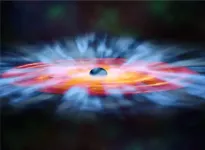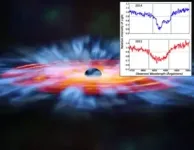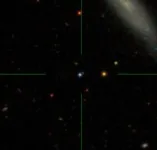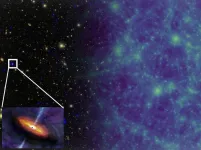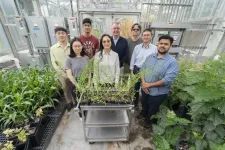(Press-News.org) Clouds of gas in a distant galaxy are being pushed faster and faster — at more than 10,000 miles per second — out among neighboring stars by blasts of radiation from the supermassive black hole at the galaxy’s center. It’s a discovery that helps illuminate the way active black holes can continuously shape their galaxies by spurring on or snuffing out the development of new stars.
A team of researchers led by University of Wisconsin–Madison astronomy professor Catherine Grier and recent graduate Robert Wheatley revealed the accelerating gas using years of data collected from a quasar, a particularly bright and turbulent kind of black hole, billions of light years away in the constellation Boötes. They presented their findings today at the 244th meeting of the American Astronomical Society in Madison.
Scientists believe black holes are situated at the center of most galaxies. Quasars are supermassive black holes surrounded by disks of matter being pulled in by the black hole’s enormous gravitational power.
“The material in that disk is always falling into the black hole, and the friction of that pulling and pulling heats up the disk and makes it very, very hot and very, very bright,” says Grier. “These quasars are really luminous, and because there’s a large range of temperatures from the interior to the far parts of the disk, their emission covers almost all of the electromagnetic spectrum.”
The bright light makes quasars nearly as old as the universe (as many as 13 billion light years away) visible, and the broad range of their radiation makes them particularly useful for astronomers to probe the early universe.
Researchers used more than eight years of observations of a quasar called SBS 1408+544, collected by a program carried out by the Sloan Digital Sky Survey now known as the Black Hole Mapper Reverberation Mapping Project. They tracked winds composed of gaseous carbon by spotting light from the quasar that was missing — light that was being absorbed by the gas. But instead of being absorbed at exactly the right spot in the spectrum that would indicate carbon, the shadow shifted farther from home with every new look at SBS 1408+544.
“That shift tells us the gas is moving fast, and faster all the time,” says Wheatley. “The wind is accelerating because it’s being pushed by radiation that is blasted off of the accretion disk.”
Scientists, including Grier, have suggested they’ve observed accelerating winds from black hole accretion disks before, but this had not yet been backed by data from more than a few observations. The new results came from about 130 observations of SBS 1408+544 made over nearly a decade, which allowed the team to solidly identify the increase in velocity with high confidence.
The winds pushing gas out from the quasar are of interest to astronomers because they are a way in which the supermassive black holes might influence the evolution of the galaxies that surround them.
“If they're energetic enough, the winds may travel all the way out into the host galaxy, where they could have a significant impact,” Wheatley says.
Depending on the circumstances, a quasar’s winds could supply pressure that squeezes gas together and speeds the birth of a star in its host galaxy. Or it could scour away that fuel and keep a potential star from forming.
“Supermassive black holes are big, but they’re really tiny compared to their galaxies,” says Grier, whose work is supported by the National Science Foundation. “That doesn’t mean they can’t ‘talk’ to each other, and this is a way for one to talk to the other that we will have to account for when we model the effects of these kinds of black holes.”
The study of SBS 1408+544, published today in The Astrophysical Journal included collaborators at York University, Pennsylvania State University, University of Arizona and others.
This research was funded in part by grants from the National Science Foundation (AST-2310211 and AST-2309930).
END
Wind from black holes may influence development of surrounding galaxies
The discovery helps illuminate the way active black holes can continuously shape their galaxies by spurring on or snuffing out the development of new stars
2024-06-11
ELSE PRESS RELEASES FROM THIS DATE:
Impact Journals sponsors 2024 Ride for Roswell
2024-06-11
Impact Journals is thrilled to sponsor Team Open Access again in the annual cycling event to end cancer, The Ride for Roswell, on June 22, 2024.
BUFFALO, NY- June 11, 2024 – The Ride for Roswell is one of the nation’s largest cycling events—hosted by Roswell Park Comprehensive Cancer Center—to raise awareness and funds for cancer research and patient care. This charity bike ride, based out of Buffalo, New York, has brought people together for 28 years to celebrate cancer survivors, pay tribute to lives that have been lost, and to work together to support research and find a cure.
THE ORIGIN OF THE RIDE
The Ride for Roswell started ...
Safer virus helps eliminate cancer
2024-06-11
· Weakened virus helps eliminate melanoma and colon cancer in mice
· Therapy is effective in treating and even preventing cancer
· Virus raises ‘red flag’ on tumors so immune cells know to attack it
CHICAGO --- Northwestern Medicine scientists have discovered that an attenuated (weakened) virus can help eliminate cancer in mice. In addition, mice that were treated with this virus were more resistant to developing tumors later in life.
The attenuated virus — lymphocytic ...
Mizzou scientists spot more Milky Way-like galaxies in early universe
2024-06-11
University of Missouri scientists are peering into the past and uncovering new clues about the early universe. Since light takes a long time to travel through space, they are now able to see how galaxies looked billions of years ago.
In a new study, the Mizzou researchers have discovered that spiral galaxies were more common in the early universe than previously thought.
“Scientists formerly believed most spiral galaxies developed around 6 to 7 billion years after the universe formed,” said Yicheng Guo, an associate professor in Mizzou’s ...
How do supermassive black holes get super massive?
2024-06-11
UNIVERSITY PARK, Pa. — By combining forefront X-ray observations with state-of-the-art supercomputer simulations of the buildup of galaxies over cosmic history, researchers have provided the best modeling to date of the growth of the supermassive black holes found in the centers of galaxies. Using this hybrid approach, a research team led by Penn State astronomers derived a complete picture of black-hole growth over 12 billion years, from the Universe’s infancy at around 1.8 billion years old to now at 13.8 billion years old.
The research comprises two papers, ...
Pilot study in JNCCN explores new approach for reducing anxiety and improving quality of life after stem cell transplantation
2024-06-11
PLYMOUTH MEETING, PA [June 11, 2024] — New research in the June 2024 issue of JNCCN—Journal of the National Comprehensive Cancer Network highlights a promising approach for alleviating distress, enhancing quality of life, improving physical function, and reducing fatigue in patients with blood cancers who undergo hematopoietic stem cell transplantation (HSCT). The study used a randomized clinical trial to evaluate the feasibility of a nine-week, phone-delivered, positive psychology program called Positive Affect for the Transplantation of ...
Controlling the precise timing of electrical pulses may offer promise for treating mild traumatic brain injury
2024-06-11
An awkward beat doesn't help on the dance floor, but it could help people who are recovering from mild traumatic brain injury (mTBI).
Publishing online today (June 11, 2024) in the Journal of Neurotrauma, Virginia Tech scientists with the Fralin Biomedical Research Institute at VTC show that specifying the timing pattern of neurostimulation – impulses used to activate the brain’s own electrical signaling mechanisms – can rebalance the strength of synaptic connections between nerve cells, selectively up- or down-regulating those connections. While the timing pattern of electrical signaling is important in the normal brain, ...
Scientists engineer yellow-seeded camelina with high oil output
2024-06-11
UPTON, N.Y. — Efforts to achieve net-zero carbon emissions from transportation fuels are increasing demand for oil produced by nonfood crops. These plants use sunlight to power the conversion of atmospheric carbon dioxide into oil, which accumulates in seeds. Crop breeders interested in selecting plants that produce a lot of oil look for yellow seeds. In oilseed crops like canola, yellow-seeded varieties generally produce more oil than their brown-seeded counterparts. The reason: The protein responsible for brown seed color — which yellow-seeded plants lack — also plays a key role in oil production.
Now, plant biochemists at the U.S. Department of Energy’s (DOE) Brookhaven ...
Specialist and migratory birds at greater risk under climate change
2024-06-11
URBANA, Ill. -- Following decades of decline, even fewer birds will darken North American skies by the end of the century, according to a new analysis by scientists at the University of Illinois Urbana-Champaign. Their study is the first to examine the long-term effects of climate change on the abundance and diversity of bird groups across the continent as a whole while accounting for additional factors that put birds at risk, such as pesticides, pollution, land use change, and habitat loss.
“Many studies try to attribute causes like climate ...
New biomarker database designed to improve astronaut health may also be useful to earthlings
2024-06-11
As space travel becomes more frequent, a new biomarker tool was developed by an international team of researchers to help improve the growing field of aerospace medicine and the health of astronauts.
Dr. Guy Trudel (Professor in the Faculty of Medicine), Odette Laneuville (Associate Professor, Faculty of Science, and Director of the Biomedical Sciences) and Dr. Martin Pelchat (Associate Professor in the Department of Biochemistry, Microbiology and Immunology) are among the contributors to an international ...
Haiku may shine a light on humans’ relationship with insects, study suggests
2024-06-11
UNIVERSITY PARK, Pa. — Haiku poems have reflected humans’ experiences in nature for hundreds of years, including observations of bugs and other wildlife. Recently, Penn State researchers analyzed which insects were mentioned the most in haiku — with butterflies, fireflies and singing insects such as crickets topping the list.
Haiku are three-line poems with five syllables in the first and third lines, and seven syllables in the second line.
In their study of nearly 4,000 haiku, recently published in the journal PLOS ONE, the researchers also found that aquatic arthropods — such as caddisflies, stoneflies and fishflies — were mentioned the ...
LAST 30 PRESS RELEASES:
World-first discovery uncovers how glioblastoma tumours dodge chemotherapy, potentially opening the door to new treatments
A fatal mix-up: How certain gut bacteria drive multiple sclerosis
New AI tool identifies not just genetic mutations, but the diseases they may cause
Deep-learning model predicts how fruit flies form, cell by cell
Combination pills for high blood pressure may simplify treatment, improve long-term health
Immune system keeps mucosal fungi in check
Neurons within the brain use simple rules to localize genetic messages
Electrodes created using light
Second-hand gift-giving is a well-deliberated decision
How human interaction drove evolution to make bears less aggressive
National Poll: Few parents offer teens guidance on healthy eating during holiday season
Cannabis derivatives could provide new ovarian cancer treatments
Raising strong yeast as a petroleum substitute
Clues to the origin of hot Jupiters hidden in their orbits
Canada’s reduced pledge to Global Fund will impact domestic health
1 in 4 children with major traumatic injuries not cared for in pediatric trauma centres
Duke and Duke-NUS’ joint cross-population research to uncover "East-West" differences in disease and care
Scientists to ‘spy’ on cancer- immune cell interactions using quantum technology breakthrough
Tech savvy users have most digital concerns
Making lighter work of calculating fluid and heat flow
Normalizing blood sugar can halve heart attack risk
Lowering blood sugar cuts heart attack risk in people with prediabetes
Study links genetic variants to risk of blinding eye disease in premature infants
Non-opioid ‘pain sponge’ therapy halts cartilage degeneration and relieves chronic pain
AI can pick up cultural values by mimicking how kids learn
China’s ecological redlines offer fast track to 30 x 30 global conservation goal
Invisible indoor threats: emerging household contaminants and their growing risks to human health
Adding antibody treatment to chemo boosts outcomes for children with rare cancer
Germline pathogenic variants among women without a history of breast cancer
Tanning beds triple melanoma risk, potentially causing broad DNA damage
[Press-News.org] Wind from black holes may influence development of surrounding galaxiesThe discovery helps illuminate the way active black holes can continuously shape their galaxies by spurring on or snuffing out the development of new stars
